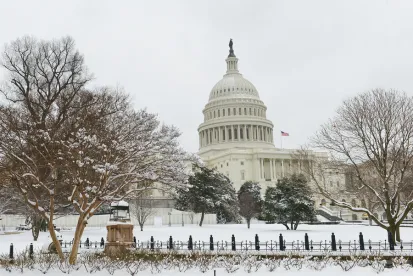On November 2, 2015, President Obama signed into law the Bipartisan Budget Agreement of 2015 (the “Act”), which includes major changes to the partnership tax audit rules (the “New Audit Rules”). The Act repeals the current partnership audit rules as well as the electing large partnership audit rules, and provides that the Internal Revenue Service (the “IRS”) will audit and collect tax from all partnerships at the entity level. However, a partnership can make an election within 45 days after the date of the notice of final partnership adjustment to shift the tax liability from the partnership to the partners. In addition, certain partnerships with less than 100 partners may elect to have the determinations made at the partner level. The New Audit Rules contained in the Act will be effective for tax years beginning in 2018. The Act is applicable to all entities treated as partnerships for federal income tax purposes, including limited liability companies that have not elected to be treated as corporations.
Private equity funds, hedge funds, MLPs and other partnerships, as well as their investors, all will be significantly impacted by the New Audit Rules and should carefully consider changes to their governing documents.
Background
Under the existing law, enacted by the Tax Equity and Fiscal Responsibility Act of 1982 (the “TEFRA Rules”), the tax treatment of partnership items generally is determined at the partnership level. Then, the IRS has the burden of recalculating the tax liability of each individual partner for the particular year subject to audit. The existing law also contains simplified audit procedures for large partnerships with 100 or more partners. However, such simplified audit procedures are elective and only apply when a large partnership makes the election. For certain partnerships with 10 or fewer partners, the unified approach in the TEFRA Rules does not apply, and the IRS generally audits each partner separately.
The Act
The Act repeals both the TEFRA Rules and the electing large partnership audit rules. Under the New Audit Rules, adjustments to partnership items are determined at the partnership level, and the partnership is responsible for any additional tax resulting from such adjustment, including any related interest, penalty or addition to taxes. Thus, instead of the aggregate approach adopted by the TEFRA Rules, the New Audit Rules take an entity approach and a partnership, otherwise a flow-through entity for federal income tax purposes, effectively becomes a taxable entity for purposes of the New Audit Rules, unless the partnership has in effect a valid election to pass the tax liability on to its partners in the year under review, as discussed further below.
Under the New Audit Rules, the IRS generally will examine the partnership’s items of income, gain, loss, deduction, credit and the partners’ distributive shares for the year under review, and any assessment will be taken into account by the partnership in the adjustment year, which generally is the year in which the final determination is made. This potentially creates an inequity between the partners that received the economic benefit or detriment from the partnership items for the year under review, and the partners of the partnership in the adjustment year, who are responsible for any additional tax liabilities resulting from the assessment.
The New Audit Rules require the partnership to pay, in the adjustment year, any “imputed underpayment” with respect to any assessment. An “imputed underpayment” generally is determined by netting all adjustments to items of income, gain, loss or deduction and multiplying such net amount by the highest rate of tax in effect for the year under review. Any adjustments to items of credit are treated as an increase or decrease, as the case may be, in the imputed underpayment.
There are certain exceptions to the general rule for calculating imputed underpayments. First, if an adjustment involves a reallocation of distributive shares of a partnership item from one partner to another, the IRS will not simply net the adjustments (which would result in a net adjustment of zero), but instead will disregard any decrease to the income or gain of a partner and any increase to the deduction, loss or credit of a partner, and will take into account only increases to income or gain and decreases to deduction, loss or credit. For example, if the partnership allocates $10 of income to partner A in the year under review, and the IRS later determines that partner B should have been allocated such $10, the imputed underpayment only will include income of $10 to partner B in the adjustment year. Thus, under the New Audit Rules, even though partner A may have paid taxes on the $10 of income in the year under review, the partnership will have to pay taxes on the same $10 of income in the adjustment year. Second, the New Audit Rules consider certain partner-level tax consequences, such as partners’ tax-exempt status. For example, partnerships can demonstrate to the IRS that a portion of an adjustment is allocable to a tax-exempt partner, potentially resulting in a decrease of an imputed underpayment. Partnerships also can establish that some corporate or individual partners benefit from lower tax rates. Third, if one or more partners file amended returns to take into account all adjustments properly allocable to such partners and pay any taxes due on such amended tax returns, the imputed underpayment amount would be reduced by the portion of the adjustment reported by such partners.
Importantly, the New Audit Rules allow a partnership to pass the adjustment through to its partners in the year under review, provided an election is made within 45 days after a notice of final partnership adjustment (the “Alternative Procedure”). Under the Alternative Procedure, the partnership issues adjusted information returns (i.e., adjusted Schedule K-1s) to the partners for the year under review, and those partners are required to reflect the adjustment on their individual returns in the adjustment year through a simplified amended-return process. All related interest, penalties, additions to tax and additional amounts are imposed at the partner level. It is expected that, in most cases, partnerships will elect to apply such alternative treatment.
The New Audit Rules include a consistency requirement for partners to generally treat each item of income, gain, loss, deduction or credit consistently with the partnership’s return unless a partner files a statement with the Secretary that identifies the inconsistency. Underpayments due to inconsistent treatment will be assessed and collected in the same manner as if such underpayments resulted from a mathematical or clerical error.
Under the New Audit Rules, partnerships are required to designate a partner or other person with substantial presence in the United States as the partnership’s representative who shall have the sole authority to act on behalf of the partnership for purposes of the New Audit Rules. If a partnership does not elect a representative, the Secretary may select any person as the partnership’s representative.
Finally, the New Audit Rules allow partnerships that have 100 or fewer partners to elect out of the entity level audit. As currently drafted, however, such election only is available when each of the partners is an individual, a C corporation (including comparable foreign entities, real estate investment trusts and regulated investment companies), an S corporation, or an estate of a deceased partner. For purposes of computing the number of partners, shareholders of an S corporation are counted as partners. If a partnership has even one partner that is itself a partnership, it may not make the election. The election must be filed each year with a timely filed federal return, and requires the partnership not only to notify the partners of its election, but also to disclose to the IRS the name and taxpayer identification number of every partner (and, if one or more of its partners is an S corporation, it also must disclose the name and taxpayer identification number of each S corporation shareholder). With a valid election, a partnership and its partners will be audited under the general rules applicable to each individual taxpayer.
Effective Date
The Act generally applies to partnership tax years beginning after December 31, 2017. However, partnerships may elect for the New Audit Rules to apply to any partnership tax return filed for partnership tax years beginning after November 2, 2015 and before January 1, 2018.
Practical Considerations
Existing partnership agreements should be reviewed and revised to address the New Audit Rules. Partnerships and their partners should decide whether the partnership will elect to have the Alternative Procedure apply and, for partnerships that meet the 100 or fewer partners requirement, whether an election out of the entity level audit should be made. Partnership agreements also should designate the partnership representative that will act on behalf of the partnership for purposes of the New Audit Rules. Such decisions should be reflected in the operating agreements of partnerships as well as offering memoranda and subscription documents in the case of private equity funds, hedge funds, MLPs and other pooled investment vehicles treated as partnerships for federal income tax purposes.
The impact of the New Audit Rules on purchase and sale agreements also should be carefully evaluated. Buyers of partnership interests can be expected to request that partnerships elect the Alternative Procedure and bind the sellers to file amended returns to properly reflect any adjustments for a prior year under review. Given the ability of partnerships to elect the Alternative Procedure, sellers of partnership interests can be expected to ask for an opportunity to participate in, if not control, audits of partnership items in a prior year under review.




 />i
/>i

